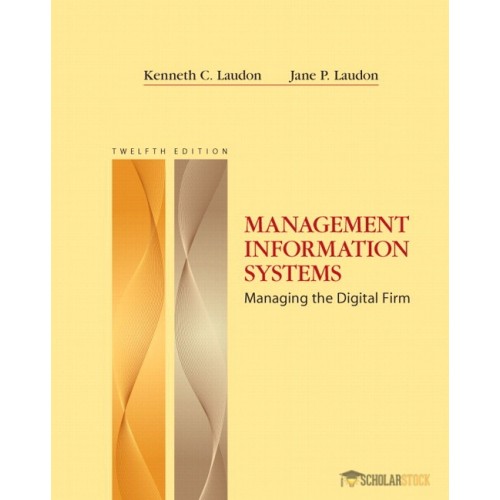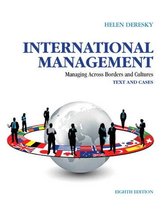Solution Manual for Management Information Systems, 12/E 12th Edition : 0132576589
$35.00
Solution Manual for Management Information Systems, 12/E 12th Edition : 0132576589
You will receive this product immediate after placing the order
A Comprehensive Solution Manual for Management Information Systems, 12/E By Ken Laudon Jane Laudon ISBN-10: 0132576589 • ISBN-13: 9780132576581
Part 1: Organizations, Management, and the Networked Enterprise
Chapter 1: Information Systems in Global Business Today
Chapter 2: Global E-Business and Collaboration
Chapter 3: Information Systems, Organizations, and Strategy
Chapter 4: Ethical and Social Issues in Information Systems
Part 2: Information Technology Infrastructure
Chapter 5: IT Infrastructure and Emerging Technologies
Chapter 6: Foundations of Business Intelligence: Databases and Information Management
Chapter 7: Telecommunications, the Internet, and Wireless Technology
Chapter 8: Securing Information Systems
Part 3: Key System Applications for the Digital Age
Chapter 9: Achieving Operational Excellence and Customer Intimacy: Enterprise Applications
Chapter 10: E-Commerce: Digital Markets, Digital Goods
Chapter 11: Managing Knowledge
Chapter 12: Enhancing Decision Making
Part 4: Building and Managing Systems
Chapter 13: Building Information Systems
Chapter 14: Managing Projects
Chapter 15: Managing Global Systems
Chapter 1
Information Systems in Global Business Today
Learning Objectives
1. How are information systems transforming business and what is their relationship to globalization?
2. Why are information systems so essential for running and managing a business today?
3. What exactly is an information system? How does it work? What are its management, organization, and technology components?
4. What are complementary assets? Why are complementary assets essential for ensuring that information systems provide genuine value for an organization?
5. What academic disciplines are used to study information systems? How does each contribute to an understanding of information systems? What is a sociotechnical systems perspective?
Chapter Outline
1.1 The Role of Information Systems in Business Today
How Information Systems Are Transforming Business
What’s New in Management Information Systems?
Globalization Challenges and Opportunities: A Flattened World
The Emerging Digital Firm
Strategic Business Objectives of Information Systems
1.2 Perspectives on Information Systems
What Is an Information System?
Dimensions of Information Systems
It Isn’t Just Technology: A Business Perspective on Information Systems
Complementary Assets: Organizational Capital and the Right Business Model
1.3 Contemporary Approaches to Information Systems
Technical Approach
Behavioral Approach
Approach of This Text: Sociotechnical Systems
1.4 Hands-On MIS
Management Decision Problems
Improving Decision Making: Using Databases to Analyze Sales Trends
Improving Decision Making: Using the Internet to Locate Jobs Requiring Information Systems Knowledge
Key Terms
The following alphabetical list identifies the key terms discussed in this chapter. The page number for each key term is provided.
Business functions, 18 Information technology (IT) infrastructure, 21
Business model, 13 Input, 16
Business processes, 11 Internet, 21
Complementary assets, 27 Intranets, 21
Computer hardware, 20 Knowledge workers, 18
Computer literacy, 17 Management information systems (MIS), 17
Computer software, 20 Middle management, 18
Culture, 20 Network, 21
Data, 15 Networking and telecommunications technology, 20
Data management technology, 20 Operational management, 18
Data workers, 18 Organizational and management capital, 27
Digital firm, 11 Output, 16
Extranets, 21 Processing, 16
Feedback, 16 Production or service workers, 18
Information, 15 Senior management, 18
Information system, 15 Sociotechnical view, 30
Information systems literacy, 17 World Wide Web, 21
Information technology (IT), 15
Teaching Suggestions
You are probably meeting in the first class session to introduce yourself, the course, and to meet the students. It is good to get to the classroom early and meet the students as they come in. Learn a few names as the students enter.
After going over any requirements you may have for the course, try to give an overview of the course stressing that this is not a technical course. Usually, you can’t do enough to put non-technical types at ease.
The opening case, “The New Yankee Stadium Looks to the Future,” shows students that even the professional sports industry has embraced technology as a way to enhance customer value and increase the business’s competitive advantage. Students will start to become familiar with the idea that many different kinds of businesses have had to change the way they operate, even Major League Baseball teams. Not only does the technology in Yankee Stadium provide new interactive services to fans both inside and out of the Stadium, but it also provides stadium attendees with useful information such as news, weather, and traffic information. The entire system is designed to help increase customer service and, hopefully, team sales, by providing a new channel for interacting with fans and making it easier for them to purchase products and services. The new technology built into the stadium shows why information systems are essential for enhancing customer service, making the business more efficient, and increasing revenues.
Section 1.1, “The Role of Information Systems in Business Today” gives students a feel for the importance of information systems in business today and how they have transformed businesses on the world stage. A good discussion of the six important business objectives outlined in this section allows the instructor and students to discuss why businesses have become so dependent on information systems today and the importance of these systems for the survival of a firm. Stress to students that information systems are not a luxury. In most businesses they are the core to survival. This would be a good time to ask students to discuss how their own schools are using information systems to enhance their product offering.
Table 1-1 is a great way to introduce students to much of the new IT jargon that has developed over the last several years. Most of the technologies will be discussed in future chapters. Ask students how much hands-on experience they’ve had with some of the new business tools as either an employee or a customer.
Globalization is affecting virtually every country in the world. The most striking evidence of this trend is the increasing presence of cell phones in the very small villages of Africa. As technology becomes more pervasive and, in some cases easier to use, globalization will continue its steady march. China, Singapore, and Russia are good examples of how globalization has flattened the world. They have become major exporters to other countries, especially industrialized and advanced countries like the U.S. and many European countries. Emerging countries, like Poland, the Ukraine, and Ireland, are excellent examples of increasing globalization.
Ask students to provide examples of truly digital firms (Cisco Systems and Dell Computers) as opposed to those businesses (local mom-and-pop stores or a local doctor’s office) that still perform many business processes outside of integrated information systems.
Review the six strategic business objectives: operational excellence, new products, services, and business models; customer and supplier intimacy; improved decision making; competitive advantage, and survival. The rest of the text will continually refer back to these six objectives as reasons why firms should incorporate and integrate business processes with information systems.
Interactive Session: Management: MIS in Your Pocket
Case Study Questions
1. What kinds of applications are described here? What business functions do they support? How do they improve operational efficiency and decision making?
Email, messaging, social networking, and sales force management are described in this case study. The applications support business functions including collaboration, location-based services, and communications with colleagues. These applications improve operational efficiency and decision making by allowing people to communicate from wherever they are. They are no longer tethered to one place or one machine. They can receive information and data instantaneously which allows them to make better, faster decisions. In the case of Doylestown Hospital, doctors use iPhone applications to access medical reference applications, giving them a broader base of information on which to base decisions.
2. Identify the problems that businesses in this case study solved by using mobile digital devices.
Doylestown Hospital customized doctors’ iPhones with secure mobile access to the hospital’s electronic medical records system. Doctors receive information on vital signs, medications, lab results, allergies, nurses’ notes, therapy results, and patient diets. Doctors can also access medical reference applications to help them interpret lab results and obtain medication information. The hospital’s information systems department can authenticate system users and track user activity. Information is stored securely on the hospital’s server computer. Doctors stay connected around the clock to hospital staff, colleagues, and patient information. The iPhone allows doctors to receive time-sensitive e-mail alerts from the hospital.
D.W. Morgan is a supply chain consultant and transportation and logistics service provider. It helps companies move critical inventory to factories that use a just-in-time inventory strategy. It has operations in more than 85 countries on four continents. It’s absolutely critical to know the exact moment when delivery trucks will arrive with supplies. In the past, it took many phone calls and a great deal of manual effort to provide customers with such precise up-to-the-minute information. It now uses a mobile digital device for its 30 drivers that update shipment information, collect signatures, and provide GPS data on each box it delivers. Drivers record pickups and status updates. They collect a signature on their iPhone screen that verifies deliveries at each destination. Data includes a date stamp and time-stamped GPS location pinpointed on a Google map. The data is available to customers on the company’s Web site.
TCHO Chocolate solved some of its operational and production problems by using iPhone apps to remotely log into each chocolate-making machine, control time and temperature, turn the machines on and off, and receive alerts about when to make temperature changes. The company owner remotely views several video cameras that show how the TCHO Flavor Lab is doing. Company employees exchange photos, email, and text messages via iPhone apps.
3. What kinds of businesses are most likely to benefit from equipping their employees with mobile digital devices such as iPhones, iPads, and BlackBerrys?
Any business with a need to communication with customers, suppliers, and business colleagues can benefit from equipping employees with mobile digital devices.
Student answers will vary as they relate their own experiences and knowledge of using mobile digital devices. Try to encourage the students’ creativity and imagination with this question. Here are a couple examples:
Insurance companies: claims adjusters or agents writing new policies or updating old ones, can take pictures of property as-is or that has been damaged, update data on the condition of a property, and document property damage for claims processing.
Real estate agents: can take pictures of homes for sale and send to prospective buyers, send information to other agents or prospective buyers and sellers, answer questions and complete documents related to buying and selling property.
Winemakers: can receive up-to-date weather forecasts, track crop information via GPS coordinates, store and access data on crop varieties for later analysis, track employee productivity during harvest time, take pictures of crops to include in a database, and communicate with suppliers and customers.
4. D.W. Morgan’s CEO has stated, “The iPhone is not a game changer, it’s an industry changer. It changes the way that you can interact with your customers and with your suppliers.” Discuss the implications of this statement.
First and foremost, those that effectively and efficiently deploy mobile digital device technology gain a huge competitive advantage over those who do not use the technology to stay in constant touch with customers and suppliers. Sales and Marketing can take a hit by not having access to information that can close business deals faster and more efficiently. Costs can increase without the ability to contact suppliers and track product shipments, especially for those companies who use just-in-time supply chains.












Reviews
There are no reviews yet.